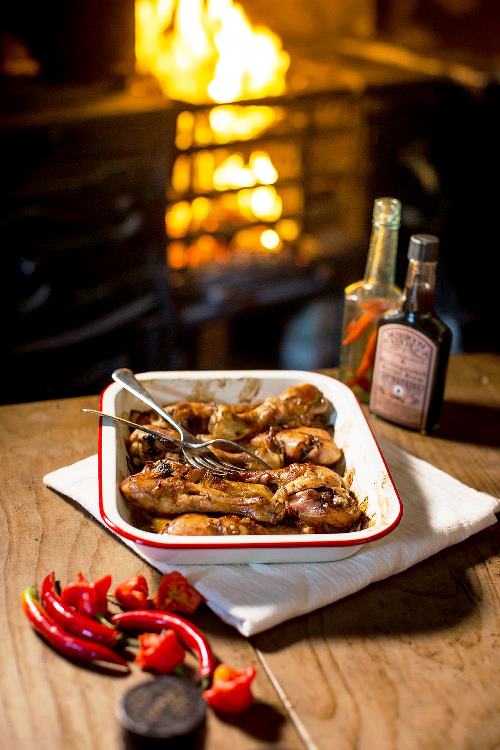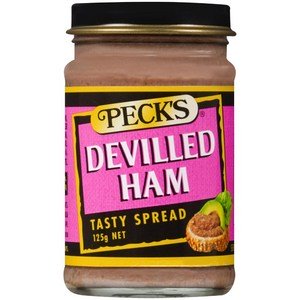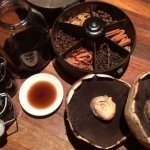If you’re celebrating Halloween this weekend, add some devilishly simple ‘devilled bones’ to the menu (recipe below). They make a nice change from the now ubiquitous honey-soy chicken legs and winglets, and are great for kids and adults alike.
Hot as Hades
‘Devilled’ foods have been popular since the 18th-century, but like many simple dishes, have faded in their glory in recent decades. They could be wet or dry – either marinated in a blend of piquant sauces and spices or cooked and served in a richly spiced sauce.
All manner of foods found themselves in the devil’s lair – chops, sausages, kidneys, chicken, eggs, oysters and even cheese, but the key characteristic is that they were ‘hot’ tasting, in the spicy sense. The heat was generally derived from mustard and cayenne pepper or chilli powder, which brought about the reference to Hades or Hell, and hence, ‘devils’ food. You can control how hot you want to make your devils, and if serving them to kids or plain eaters, make them fairly mild and add a splash of chilli or Tabasco sauce, or in true 19th-century style – and my favourite option – a good splash of chilli vinegar for extra pep (recipe below).

Devilled Bones cooling the kitchen at Vaucluse House Photo © James Horan for Sydney Living Museums, from Eat your history, stories and recipes for Australian kitchens (Sydney Living Museums and NewSouth Publishing, 2015).
The devil is in the detail
There are dozens of Devil recipes in old cookery books (the one I’ve adapted for modern measurements at the end of the page is from Kathleen Rouse’s 1856 ‘A shilling cookery book for the people‘). They all very practical as they used basic pantry ingredients that could be put together quickly and deliver a good punchy flavour without too much fuss. Many recipes remain faithful to the mustard and cayenne, often with a variety of other elements added for complexity: mushroom ketchup or Worcestershire sauce, anchovies and anchovy sauce, vinegar, curry powder and fruit chutneys, some therefore taking on a sweet, hot, sour profile. Tomato sauce crept into the range in the early 1900s. By the early 20th-century devilled dishes are generally included in the breakfast and luncheon sections of cookbooks; devilled cheese or biscuits in the savouries section.
Devilled Bones – Mrs Maclurcan’s cookery book, 1903
Remains of cold [cooked] shoulder of mutton; chicken bones (or bones of any cold [cooked] poultry), mustard, butter, cayenne.
Mode: chop the bones to a medium size, score them with a knife. Mix about a teaspoon of dry mustard with an ounce of butter and a little cayenne; spread it in the scores cut in the meat, grill it over a nice clear fire; while very hot put on a little more butter. Serve on a very hot plate with chip potatoes.Sauce for Devilled bones – The Goulburn cookery book, 1928
One teaspoon of mustard, 1 teaspoon of Worcester sauce, 1 tablespoon of oiled butter or salad oil, 1 teaspoon of vinegar, 1/2 teaspoon of salt, a few drops of anchovy sauce (if liked), a little cayenne.
Mix all well together, and having scored the poulty legs across, pour the sauce into the scores, and let them lie all night. Grill in the morning, and serve very hot. Leg or shoulder of mutton bones, but into four, are very nice done with this sauce.Indian Devil mixture. A nice devil (Admiral Ross’s) – The Kookaburra cookery book. 1912.
4 tablespoons of cold gravy; 1 tablespoon of chutney; 1 tablespoon ketchup; 1 tablespoon vinegar; 2 teaspoons of made mustard; 2 saltspoons of salt; 2 tablespoons of butter.
Mix all ingredients as smooth as possible in a soup plate, put with it poultry or meat, whatever you wish to devil. Stew gently until warmed. Remove meat and grill for 3 minutes. Pour over gravy and serve on hot dish and you will have a delicious devil.
Mrs Noltenius.
I’m not quite sure who the aforesaid Admiral Ross was, but his devil recipe is exactly the same – verbatim – of ‘A wet devil’ published in The Goulburn cookery book, 1895 !!
The devils’ demise
Before curries became all the rage for leftover cooked meat, a devilled sauce was a handy solution. Similarly, rare or under-cooked meat that was close to the bone after roasting could be rubbed with the marinade and baked or grilled to cook through. This became less of a need once oven-baking rather than roasting joints of meat became common in the late 1900s, as the bone itself becomes a heat conductor, cooking the meat from within. I wonder if this, perhaps, is when devils started to lose their relevance on our tables.
Peck’s devilled ham spread.
One lasting remnant of devilled dishes appears to be commercial ‘devilled ham paste’ – a derivative of potted meat tradition (which we will visit in a future story). Devilled cheese is another savoury topping – being a variation of the classic Welsh Rarebit, or Rabbit (both titles are historically correct, depending which text you reference!)
Devilled cheese – The Kookaburra cookery book, 1912.
Slice into a stewpan about a heaped tablespoon of cheese; ad 1 tablespoon of cream; a little cayenne; 1 teaspoonful of mustard; 1 teaspoon of Worcester sauce. Lay the mixture on strips of toast or fried bread and serve very hot.
Mrs Christison, Clare [S.A]
Spanish ‘Chicken Diablo’ (diablo meaning devil’) is still popular in America, but rather than retaining its characteristic chilli heat, seem now to be made with sweet ‘bell peppers’ or capsicum.
Devilled bones
Ingredients
- 6 chicken legs (drumsticks)
- 2 teaspoons hot English mustard (or French mustard for a milder flavour)
- 1 tablespoon tablespoon worcestershire or HP sauce
- pinch cayenne pepper
- 1 teaspoon curry powder (optional)
- dash apple cider vinegar (or chilli vinegar)
Note
This is a dry ‘devil’ for meats on the bone, adapted from Kathleen Rouse’s copy of Alexis Soyer’s A shilling cookery for the people (1856), which remains in the collection at Rouse Hill House and Farm.
You can use beef or lamb ribs instead of chicken, and play with the flavour ratios.
Directions
| Using a sharp knife, make a few 3-cm incisions in the flesh of the chicken legs. Mix the remaining ingredients together in a bowl, adjusting quantities to suit your taste. Add the chicken and rub the marinade into the flesh. Marinate for an hour or more in the fridge. Preheat the oven to 180°C (160°C fan-forced). Put the chicken in the base of an ovenproof dish and pour over any remaining marinade. Bake for 1 hour, turning once or twice to ensure an even colour. | |
Chilli vinegar
Ingredients
- 375ml bottle of good-quality white vinegar
- 15 fresh red chillies, or to taste (slit lengthways, keeping the tops intact)
Note
An old English alternative to Tabasco sauce, this condiment was originally intended as a dressing for fish, which, according to Mrs Beeton, 'many people cannot eat without the addition of an acid and cayenne pepper'. A splash of chilli vinegar adds zing to all kinds of sauces, dressings, marinades and cooked meats.
Directions
| Remove the lid from the bottle of vinegar and carefully prise off the 'splash' lid, if there is one. Drop the chillies into the vinegar and reseal. Leave to infuse for at least 2 weeks before using. The vinegar will keep for up to 12 months, and the flavour will intensify over time. | |


 Print recipe
Print recipe
